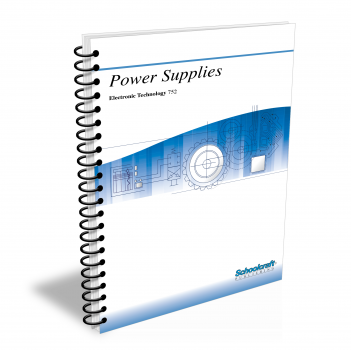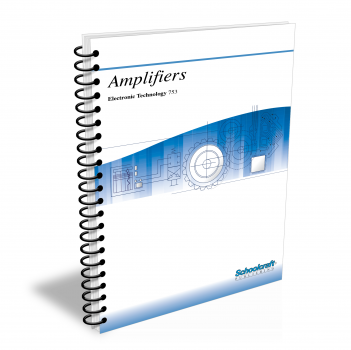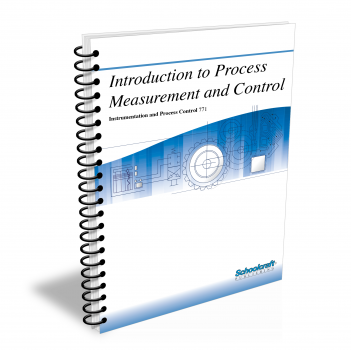Power Supplies

Course Number: 752
The Power Supplies textbook describes the four basic kinds of power supply conversions. It explains how to work with nonchemical cells as well as primary and secondary cells of various materials. It describes in detail the functions and operation of several kinds of rectifiers, filters, and voltage regulators and explains how they work together as power conditioners. Finally, the course discusses basic tools, test devices, and procedures for troubleshooting to solve the greatest number of problems in the least amount of time.
Does your curriculum require additional topics not included in this textbook? Build a customized version of the Power Supplies textbook below.
Recommended Contact Hours – 9
Preview a Chapter
Available Supporting Material
- Table of Contents
- Exam Copies
- Suggested Titles
Table of Contents
Chapter 1: Power Supplies and Power Conditioners
Topics: Power supply and power conditioner functions; DC-to-DC, AC-to-AC, AC-to-DC, and DC-to-AC power supplies; Inverter feedback circuits; Power conditioners; Safety precautions
Learning Objectives:
- Discuss the basic functions of power supplies and power conditioners.
- Describe dc-to-dc, ac-to-ac, ac-to-dc, and dc-to-ac power supplies.
- Compare the operation of transformer-driven and oscillator-driven inverters.
- Discuss the functions of filters, voltage regulators, voltage dividers, switching power supplies, and ferroresonant power supplies.
- Explain why low voltages can be dangerous.
Chapter 2: Cells and Batteries
Topics: Electrochemical cells; Primary, secondary, lead-acid, nickel-cadmium, nickel-metal-hydride, and nickel iron cells; Maintenance, hazards, and precautions; Nonchemical cells
Learning Objectives:
- Explain the difference between a battery and a cell and identify symbols for each.
- Describe the parts of an electrochemical cell.
- Compare the characteristics and uses of Leclanch�, high-energy, and alkaline carbon-zinc cells.
- Discuss battery-recharging problems and explain how to check for overcharging.
- Discuss ways to maintain and dispose of chemical cells and batteries safely.
- Discuss the use of five kinds of nonchemical energy sources and recent developments in cells and batteries.
Chapter 3: Rectifiers
Topics: Diode rectifiers and ratings; Parallel and series diodes; Half-, full-wave, bridge, and three-phase rectifiers; Voltage multipliers
Learning Objectives:
- Define the term rectifier.
- Explain how to interpret diode ratings on a manufacturer's specification sheet.
- Compare the effects of connecting diodes in parallel and in series.
- Describe the operation of a silicon-controlled rectifier.
- Compare the operation of half-wave and full-wave rectifiers.
- Discuss the operation of bridge and three-phase rectifiers and explain how voltage multipliers work.
Chapter 4: Filters
Topics: Kinds of filters; Ripple; Circuit components; Bleeder resistors; Bypass filters; Input filters
Learning Objectives:
- Name several kinds of filters used in power supplies.
- Discuss the effects of ripple and describe ways ripple is measured.
- Discuss the use of capacitors, inductors, and resistors in filter circuits.
- Compare the advantages and disadvantages of capacitance, inductance, RC, and LC power supply filters.
- Explain why capacitor power supplies should include bleeder resistors.
- Discuss the uses of bypass filters and input filters.
Chapter 5: Voltage Regulators
Topics: Voltage regulators; Shunt, series, integrated circuit (IC), switching, and primary circuit regulators
Learning Objectives:
- Discuss the purposes of voltage regulators in power supplies.
- Explain the function of the control circuit and the current limiting circuit in series voltage regulators.
- Discuss the advantages of IC voltage regulators.
- Describe the operation of switching regulators and explain how it differs from that of other kinds of regulators.
- Discuss the use of SCRs and triacs in primary circuit regulators.
Chapter 6: Troubleshooting Power Supplies
Topics: General approach; Preliminary checks; Power-off, power-on tests; Output tests; Section tests; Part tests
Learning Objectives:
- Discuss at least five kinds of test equipment and tools used to troubleshoot power supplies.
- Describe the three main steps in troubleshooting a power supply.
- Describe the basic procedures for preliminary checks and power-off visual inspection and fuse tests.
- Describe the basic procedures for power-on tests and output tests.
- Explain how to perform section tests and part tests.
Request Exam Copies
Exam Copies
Ready to see a copy of our textbooks? After selecting which textbooks you’d like to review for your course, you can submit your request by either logging in or creating an account so we know where to ship your exam copies. A representative from Schoolcraft will contact you to confirm and finish processing your request.
Exam copies are always free and yours to keep.
Selected Exam Copies
none selected
* Maximum of five copies can be ordered


